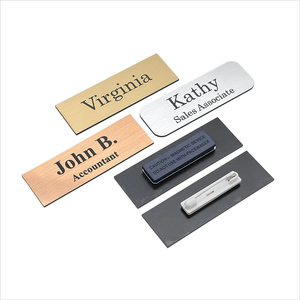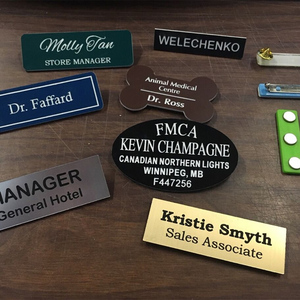
All categories
Featured selections
Trade Assurance
Buyer Central
Help Center
Get the app
Become a supplier

(1915 products available)















































Unique name tags are personalized and distinctive labels or tags used to identify individuals. They often include a person's name and may incorporate additional elements such as a photo, logo, or artistic design to make them stand out. Unique name tags are commonly used in various settings such as events, conferences, workplaces, or social gatherings to enhance recognition and add a personal touch. They can be created using various materials and techniques, including printing, embossing, or engraving, and can be designed to reflect personal style or the theme of an event.
Magnetic Name Tags
Magnetic name tags are a popular and practical choice for various settings, including corporate events, conferences, and daily workplace use. Unlike traditional pin or adhesive tags, magnetic name tags utilize strong magnets to attach securely to clothing without causing damage or leaving residue. This method ensures a flat and comfortable fit, preventing the tag from shifting or falling off. These tags are often made from materials like plastic, metal, or laminated paper, providing durability and a professional appearance. Customization options typically include printing or engraving names, logos, and other relevant information, making them versatile for branding and personal identification.
Personalized Tags
Personalized name tags offer a unique way to identify individuals while reflecting their personality or the theme of an event. Unlike standard name tags, which simply display a name, personalized tags can include additional elements such as photographs, custom graphics, or special fonts. These tags are often used in social gatherings, weddings, or corporate events where a more individualized approach is desired. They can be crafted from various materials, including plastic, metal, wood, or fabric, and can be designed to match the color and style of the event. The personalization adds a touch of creativity and can enhance the overall experience by making each guest feel recognized and valued.
Reusable Name Tags
Reusable name tags are a sustainable and cost-effective solution for environments where individuals may change roles or where the same tag may be needed for multiple events. These tags are typically made from durable materials, such as plastic or acrylic, and come with a write-on, wipe-off surface or a system of interchangeable inserts. The write-on, wipe-off feature allows for easy customization using special markers that can be effortlessly erased and replaced as needed. Alternatively, interchangeable inserts allow users to print or write their information on paper inserts, which can be swapped out without changing the entire tag. Reusable name tags are ideal for educational settings, corporate training sessions, and community events, promoting a greener approach by reducing the need for single-use plastic name tags.
The design of name tags is aimed at developing a distinct and memorable depiction of an individual or an organization. The prominent elements in the design include the logo, name, title, and vivid colors. Usually, the logo is placed in a conspicuous position, and the name is marked in big readable fonts. The title follows the name and is written in smaller fonts. Moreover, the background colors are bright and bold, thus making the name tag stand out. Some designs include patterns or images that are related to the person's profession or interests. Overall, the design aims at creating a positive impression and easy recognition of a person or organization.
Unique name tags can be worn and matched in various ways to enhance their visibility and blend with different outfits. When attending formal events, a custom name tag can be pinned on the left side of the chest, just above the heart, while the wearer is in a suit or a formal dress. It should be done discreetly to ensure it does not distract from the overall look. For a business meeting or conference, the name tag must be worn in a professional manner, usually pinned to the blazer or dress, or attached to a lanyard and worn around the neck.
In casual settings, unique name tags can be worn in a more relaxed style. For instance, a name tag can be attached to a favorite t-shirt or hoodie, or it can be pinned to a jacket or bag. It is a perfect way of adding a personal touch to an outfit. For outdoor events or festivals, a name tag can be attached to a lanyard and worn around the neck, or it can be pinned to a hat or cap. This ensures that the name tag is visible and the individual does not lose it in the course of the activities.
When it comes to matching, it's important to consider the colors and patterns of the unique name tag and the rest of the outfit. If the name tag has bright colors or bold patterns, it should be balanced with more neutral or solid-colored clothing to avoid clashing. Conversely, if the name tag has a more subdued color palette, it can be paired with brighter or patterned clothing to create a focal point. Additionally, the material of the name tag should also be considered. Name tags made of metal or plastic have a more formal look and should be matched with corresponding materials in the clothing, such as metal accessories or plastic fabric.
Accessories also play a significant role in wearing and matching name tags. Pins and badges should be complemented with similar accessories that the wearer is in, like cufflinks or a brooch for a formal look. For a casual look, matching the name tag with a bracelet or keychain is acceptable. Lanyards used for hanging name tags should be chosen based on their color and material. Fabric lanyards are suitable for casual occasions, while nylon or metal lanyards are ideal for formal events.
Ultimately, wearing and matching unique name tags requires attention to detail and consideration of the overall aesthetic. By following these suggestions, one can ensure that their name tag is not only functional but also a stylish addition to their outfit. Whether for a formal event, a business meeting, or a casual outing, unique name tags can be customized to reflect personal style and enhance one's appearance.
Q1: What materials are name tags made of?
A1: Unique name tags are crafted from various materials. These include plastic, metal, fabric, and wood. Each material offers distinct aesthetic and functional benefits. For instance, plastic tags are lightweight and versatile. Metal tags, on the other hand, provide strength and durability. Fabric name tags are flexible and comfortable, while wooden tags offer a natural and rustic appeal.
Q2: How can one ensure that a name tag is visible?
A2: To ensure name tags are visible, certain factors need to be considered. First, the design should be clear and legible from a distance. It should include a readable font and contrasting colors. Second, the tag should be worn in an accessible position. This is, for example, at chest level. Third, adequate lighting in the environment should be ensured. This enhances visibility. Finally, avoid overcrowding the tag with excessive information.
Q3: Are unique name tags suitable for both indoor and outdoor use?
A3: Yes, unique name tags can be used indoors and outdoors. Their suitability is dependent on the material and design used. Tags made from durable and weather-resistant materials are ideal for outdoor settings. For instance, metal and plastic tags are preferable. They withstand environmental factors such as moisture and sunlight. However, fabric tags are more suitable for indoor use. This is because they are less resilient to harsh weather conditions.
Q4: How can one choose the right font for a unique name tag?
A4: When selecting a font for a name tag, readability should be prioritized. This is especially from a distance. The design's purpose and audience should be considered. Some popular fonts include Arial, Times New Roman, and Calibri. They are easily readable. Decorative fonts should be used sparingly. This is because they may compromise clarity.